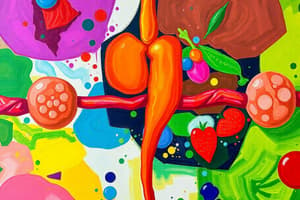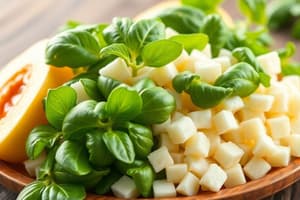Podcast
Questions and Answers
Apa yang terjadi setelah gula-gula sederhana diserap ke dalam aliran darah?
Apa yang terjadi setelah gula-gula sederhana diserap ke dalam aliran darah?
- Hati mengubah gula-gula sederhana menjadi glukosa dan fruktosa. (correct)
- Gula-gula sederhana dibuang dari tubuh melalui urine.
- Gula-gula sederhana langsung digunakan oleh sel-sel untuk menghasilkan energi.
- Gula-gula sederhana disimpan di dalam otot sebagai glikogen.
Apa yang terjadi saat hati memecah glikogen yang disimpan?
Apa yang terjadi saat hati memecah glikogen yang disimpan?
- Hati akan mengubah glikogen menjadi fruktosa dan melepaskannya ke dalam aliran darah.
- Hati akan mengubah glikogen menjadi glukosa dan melepaskannya ke dalam aliran darah. (correct)
- Hati akan mengubah glikogen menjadi protein dan melepaskannya ke dalam aliran darah.
- Hati akan mengubah glikogen menjadi asam lemak dan melepaskannya ke dalam aliran darah.
Apa yang terjadi selama glikolisis?
Apa yang terjadi selama glikolisis?
- Satu molekul glukosa dipecah menjadi dua molekul piruvat, tanpa menghasilkan ATP.
- Satu molekul glukosa dipecah menjadi dua molekul piruvat, menghasilkan dua molekul ATP. (correct)
- Satu molekul glukosa dipecah menjadi empat molekul piruvat, menghasilkan delapan molekul ATP.
- Satu molekul glukosa dipecah menjadi satu molekul piruvat, menghasilkan empat molekul ATP.
Apa tujuan utama metabolisme karbohidrat?
Apa tujuan utama metabolisme karbohidrat?
Apa yang dimaksud dengan respirasi seluler?
Apa yang dimaksud dengan respirasi seluler?
Mana dari tiga jenis karbohidrat utama yang tidak dapat dipecah menjadi gula sederhana dengan hidrolisis?
Mana dari tiga jenis karbohidrat utama yang tidak dapat dipecah menjadi gula sederhana dengan hidrolisis?
Apa yang merupakan contoh disakarida yang terbentuk dari gabungan glukosa dan fruktosa?
Apa yang merupakan contoh disakarida yang terbentuk dari gabungan glukosa dan fruktosa?
Apa perbedaan utama antara disakarida dan polisakarida?
Apa perbedaan utama antara disakarida dan polisakarida?
Manakah dari berikut ini yang merupakan fungsi polisakarida dalam organisme?
Manakah dari berikut ini yang merupakan fungsi polisakarida dalam organisme?
Apa komponen utama dari selulosa, yang merupakan komponen struktural dinding sel tumbuhan?
Apa komponen utama dari selulosa, yang merupakan komponen struktural dinding sel tumbuhan?
Flashcards are hidden until you start studying
Study Notes
Carbohydrates are one of the primary energy sources for organisms, including humans. They play crucial roles in various bodily processes such as cellular respiration, thermoregulation, and immune response. This article discusses carbohydrate metabolism.
Definition of Carbohydrates
Carbohydrates are organic compounds composed primarily of carbon, hydrogen, and oxygen atoms, with the general formula Cn(H2O)n. They can be classified into three broad categories based on their molecular structure: monosaccharides, disaccharides, and polysaccharides.
Monosaccharides
Monosaccharides, also known as simple sugars, are the simplest form of carbohydrates. They contain only one sugar molecule, usually with six carbon atoms. Examples of monosaccharides include glucose, fructose, and galactose.
Disaccharides
Disaccharides, also known as complex sugars, are formed by the combination of two monosaccharides. They have a general formula of CnH2nO11. Examples of disaccharides include sucrose (glucose + fructose), lactose (glucose + galactose), and maltose (glucose + glucose).
Polysaccharides
Polysaccharides are formed by the combination of multiple monosaccharide units. They serve as energy storage molecules for organisms. Examples of polysaccharides include starch, glycogen, and cellulose.
Digestion of Carbohydrates
The digestion process begins with the mouth where enzymes such as amylase break down starches into simple sugars like glucose, fructose, and sucrose. These simple sugars then pass through the stomach and small intestine, where they are absorbed into the bloodstream.
Once in the bloodstream, these simple sugars travel to the liver, which converts them into glucose or fructose. The liver also synthesizes glycogen from excess dietary carbohydrates. When needed, the liver breaks down its stored glycogen back into glucose and releases it into the bloodstream.
Carbohydrate Metabolism
Carbohydrate metabolism is the set of processes that use carbohydrates in food for growth and energy production in cells. There are two main stages involved in carbohydrate metabolism: glycolysis and cellular respiration.
Glycolysis
Glycolysis is the breakdown of one molecule of glucose to produce two molecules of pyruvate, generating a net gain of two ATP molecules (energy currency). This process occurs both in the cytoplasm and mitochondria.
Cellular Respiration
Cellular respiration involves three steps: glycolysis, the citric acid cycle (also known as the Krebs cycle or tricarboxylic acid cycle), and oxidative phosphorylation. During glycolysis, two ATP molecules are produced. In the citric acid cycle, more ATP molecules are generated along with reducing power for electron transport chains. Oxidative phosphorylation is responsible for producing the majority of cellular ATP from the energy stored in molecular oxygen.
Dietary Recommendations for Carbohydrates
The World Health Organization recommends consuming carbohydrates that contribute less than 10% of total energy intake from free sugars. Free sugars should exclude sugars naturally present in milk and fruits.
Conclusion
Carbohydrates play a vital role in providing energy to organisms, serving as crucial components in cellular respiration processes. Understanding carbohydrate metabolism allows us to appreciate the importance of maintaining a balanced diet with appropriate carbohydrate consumption for optimal health.
Studying That Suits You
Use AI to generate personalized quizzes and flashcards to suit your learning preferences.




